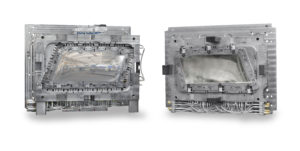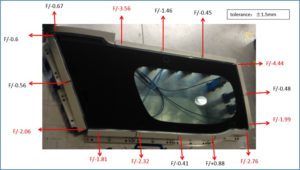
Right and left mould. Their manufacturing has required a detailed study of the mechanical and rheological characteristics of materials to obtain the best quality of the finished part.
 A new plastic injection system allows manufacturing at best highly complex bi-material parts for the automotive industry.
A new plastic injection system allows manufacturing at best highly complex bi-material parts for the automotive industry.
As well known, in automotive ambit it is very topical the issue of the replacement of glass elements (windows, sunroofs, spoilers, rear windows and so on) with polycarbonate components. It is not a mere trend but a real need dictated by the regulations on the matter, more and more severe, which ask car manufacturers to reduce the weight of cars. Since the polycarbonate has a specific weight under the half of the glass one, its use implies a reduction of fuel consumptions, an improvement of the environmental impact and the extension of the autonomy of electric or hybrid models. Besides, thanks to a much higher insulating power than glass’, the use of polycarbonate elements improves the efficacy of the conditioning/heating systems inside the car, further decreasing consumptions. In the ambit of that trend, today consolidated, we intend to analyse thoroughly a further aspect. For some years, car companies have been asking their suppliers to implement no more simple polycarbonate parts but more complex components able to integrate also the “structure” around the transparent element, generally made of PC/ABS (Polycarbonate and Acrylonitrile-Butadiene-Styrene), a mixture that combines high machinability, high resistance to collisions and heat and excellent mechanical properties.
Ten moulds in one

FLEXflow, the servo-controlled shutter system, allows attaining a precise, stable and simple control of pressure and injection flow.
To go deeply into the matter, we have “interviewed” INglass S.p.A., headquarters at San Polo di Piave (TV), international outstanding Group in the design and manufacturing of injection moulds and hot runners. Roberto Fagarazzi, Lighting and Glazing Business Unit Manager of the Venetian Group explains: «For some years now, we have been specialized in the manufacturing of moulds for bi-material components, i.e. where is present not only the transparent phase but also the structural one that allows their immediate assembly in the vehicle. This solution provides great advantages: in a single part are integrated the transparent element, the frame, the fixing elements and seals, etc.; actually, today with a single mould it is possible to implement what in the past needed even ten or more moulds». The development of a mould of this kind is however very complex and needs in-depth analyses, tests and corrections. Fagarazzi: «It is necessary to grant not only an excellent aesthetic outcome but also the dimensional conformity and the minimal deformation of the moulded part, to allow the perfect assembling». In this article, as “remarkable” example, INglass proposes our readers the case of a mould for the implementation of a polycarbonate side window integrated into its PC/ABS structure. «The component at stake – adds Fagarazzi – has notable sizes, equal to around 1,200 x 460 mm, with very strict dimensional and shape tolerances, within 1.5 mm». INglass has been manufacturing moulds for the implementation of this kind of items for over ten years and, recently, through the Ermo trademark. Fagarazzi: «Inglass was the first company in the world that introduced, already in 2004, a plastic bi-material sunroof, thus integrating the transparent phase with the dark structural one. Today this type of technology is taking hold also for other automotive components such as headlights, side and real window glasses». In the case of the side window presented in this article, Fagarazzi adds: «It is the first mould intended for the Chinese market».
A new way of injecting plastic

“Mould – tolerance” comparison before and after: the application of the FLEXflow system has allowed keeping under control the process variables, minimizing the material deformations while cooling.
 The mould implementation, a very delicate activity, was enabled especially by a new technology called “FlexFlow”, developed by INglass itself in 2014. Roberto Fagarazzi: «The moulding process of big-size components, like for instance the bumper, the dashboard and the wheel arc and so on, provides for the plastic injection through more injection points to avoid too high pressures in a single point and the material solidification before filling the entire cavity». “Sequential solutions” are generally used, i.e. systems that provide for the initial opening of the central injection point, then of the two adjacent points and so on, as the plastic flow gradually expands inside the mould. «The not simultaneous but instead “the relay” opening of the injectors – further adds our interviewee – grants a homogeneous filling of the mould and avoids that the various flows generated by the injection points interfere one another». Nevertheless, that system, even if refined, is not perfect, yet: «Whenever an injector is opened, a flow of plastic material is suddenly released inside the mould. This creates a drop of pressure inside the system that changes for some instants the initial conditions of temperature, of flow speed, of pressure etc. Those changes generate local defects on the moulded part». The “FlexFlow” system developed by INglass solves that inconvenience since it allows the controlled opening of the injectors, as Roberto Fagarazzi illustrates: «The plastic injection is generally controlled by a pneumatic or hydraulic shutter. In our system, the shutter drive is instead electric, because it is controlled by a servomotor with encoder. This allows determining exactly the opening and closing profiles of shutters and then adjusting the single flows entering the mould cavity». Therefore, setting times, opening/closing speeds and so on of the single injection points it is possible to control by 100% the flow inside the mould and to obtain a fully balanced and homogeneous filling of the cavity, thus avoiding all kinds of defects on the moulded component. The determination of the optimal opening/closing profiles of the injection points is not simple, especially for an asymmetric part like the window we are analysing. «The mould under examination is very complex not only because it is not symmetric but also because it features thickness variations, holes, cavities, inserts, etc., then the setting of the sequence of opening profiles was not trivial and needed a long analysis time», specifies Fagarazzi. In this development time, we have carried out various simulations by varying operation parameters and conditions through the Moldflow software, customized by IT technicians of INglass in collaboration with the team of the software-house Autodesk. Afterwards, we executed the moulding tests on press, in order to perfect them and to validate the initial theoretical analysis, thus achieving the optimal result. Fagarazzi: «During the first moulding phases, the moulded parts were not compliant with tolerances, with deviations by even 4-5 mm in the most critical zones. Thanks to the introduction of 10 injection points and as many electric servomotors, with which we have balanced times, increasing and decreasing the opening/closing speed of shutters, depending on their positioning inside the mould, we succeeded in conforming to the required tolerance of 1.5 mm. In particular, we have optimized the filling of the dark structural part made of PC/ABS that, having a more articulated shape compared to the transparent one, proved to be more complex. Without the “FlexFlow” system, it would have been difficult indeed to achieve this result». It is worth specifying that for the design of the mould, and in particular of the hot runner, IT engineers of INglass have used, besides Moldflow, sophisticated software developed by their computer technicians to consider and to foresees specific parameters such as the pressure drop, the electric power absorbed by the system and so on.
The mould implementation, a very delicate activity, was enabled especially by a new technology called “FlexFlow”, developed by INglass itself in 2014. Roberto Fagarazzi: «The moulding process of big-size components, like for instance the bumper, the dashboard and the wheel arc and so on, provides for the plastic injection through more injection points to avoid too high pressures in a single point and the material solidification before filling the entire cavity». “Sequential solutions” are generally used, i.e. systems that provide for the initial opening of the central injection point, then of the two adjacent points and so on, as the plastic flow gradually expands inside the mould. «The not simultaneous but instead “the relay” opening of the injectors – further adds our interviewee – grants a homogeneous filling of the mould and avoids that the various flows generated by the injection points interfere one another». Nevertheless, that system, even if refined, is not perfect, yet: «Whenever an injector is opened, a flow of plastic material is suddenly released inside the mould. This creates a drop of pressure inside the system that changes for some instants the initial conditions of temperature, of flow speed, of pressure etc. Those changes generate local defects on the moulded part». The “FlexFlow” system developed by INglass solves that inconvenience since it allows the controlled opening of the injectors, as Roberto Fagarazzi illustrates: «The plastic injection is generally controlled by a pneumatic or hydraulic shutter. In our system, the shutter drive is instead electric, because it is controlled by a servomotor with encoder. This allows determining exactly the opening and closing profiles of shutters and then adjusting the single flows entering the mould cavity». Therefore, setting times, opening/closing speeds and so on of the single injection points it is possible to control by 100% the flow inside the mould and to obtain a fully balanced and homogeneous filling of the cavity, thus avoiding all kinds of defects on the moulded component. The determination of the optimal opening/closing profiles of the injection points is not simple, especially for an asymmetric part like the window we are analysing. «The mould under examination is very complex not only because it is not symmetric but also because it features thickness variations, holes, cavities, inserts, etc., then the setting of the sequence of opening profiles was not trivial and needed a long analysis time», specifies Fagarazzi. In this development time, we have carried out various simulations by varying operation parameters and conditions through the Moldflow software, customized by IT technicians of INglass in collaboration with the team of the software-house Autodesk. Afterwards, we executed the moulding tests on press, in order to perfect them and to validate the initial theoretical analysis, thus achieving the optimal result. Fagarazzi: «During the first moulding phases, the moulded parts were not compliant with tolerances, with deviations by even 4-5 mm in the most critical zones. Thanks to the introduction of 10 injection points and as many electric servomotors, with which we have balanced times, increasing and decreasing the opening/closing speed of shutters, depending on their positioning inside the mould, we succeeded in conforming to the required tolerance of 1.5 mm. In particular, we have optimized the filling of the dark structural part made of PC/ABS that, having a more articulated shape compared to the transparent one, proved to be more complex. Without the “FlexFlow” system, it would have been difficult indeed to achieve this result». It is worth specifying that for the design of the mould, and in particular of the hot runner, IT engineers of INglass have used, besides Moldflow, sophisticated software developed by their computer technicians to consider and to foresees specific parameters such as the pressure drop, the electric power absorbed by the system and so on.
From the workshop to the production
Once obtained the optimal configuration and after the project has been approved by the customer, INglass started the production of the mould, better, of the two moulds, dealing with the right side window and the corresponding left one. Fagarazzi: «Inside our manufacturing unit are installed stock removal machines for roughing and finishing operations, of various sizes and brands, operating 24 hours a day, 7 days a week, and various EDM machines. The feather in the cap of the toolshop is constituted by four 5-axis big-size roughing centres by Mazak, each of them equipped with 300-pocket tool magazine, automated tool changer and five pallet-loading stations». This means that moulds were machined in fully automated manner. «The most delicate part of the mould making – further adds Fagarazzi – concerned the “bordering” zone between the two materials». The profile of the polycarbonate phase, in fact, and the PC/ABS one were implemented to be perfectly “matching”, to avoid that, once launched in production, the transparent part moulded by injection-compression in the first station of the press itself is polluted by the dark part moulded in the second station of the press.
«After over two years since the beginning of the works, the production of these two moulds is likely to start towards the end of 2016 by the Chinese customer», ends Roberto Fagarazzi.
Automotive: the future is in innovation
Innovation in the car industry has always made great strides. As said, one of the main trends consists in manufacturing more components in a single moulding phase: lights, support and linking structures, aesthetical parts etc. Moreover, in the ambit of the glass replacement with plastic material, new solutions are under study, for instance concerning the windscreen. Fagarazzi: «Compared to the sunroof, windows and so on, the windscreen is a more delicate component and until now it can only be made of glass, being more resistant to the abrasion of the windscreen wipers than polycarbonate. New materials are anyway under study and I think that in a quite short time we will be able to manufacture the first thermoplastic windscreens». Finally, it is important to mention the evolution of the new components to be implemented by moulding. Fagarazzi: «Dashboards, for instance, will be requested to integrate more and more complex “service” and “entertainment” systems such as screens, audio readers, connection systems and so on. On the other hand, the future is clear: in the lapse of few years, cars that do not need the driver will be released on the market and all passengers will have to spend the time in some ways».
A Group of international renown
INglass S.p.A. is an international reference Group that, since 1987, has supplied not only moulds and injection systems but also engineering and consulting services for the implementation of plastic items. Through ERMO (mould development and production) and HRSflow (development and production of hot runners) trademarks, the company operates with all-round know-how, supporting final customers since the early design phases and supplying advanced solutions in the mould sector, especially in the automotive lighting ambit (headlights). The Group, which currently employs more than 1,000 workers and is headquartered at San Polo di Piave, in Treviso province, relies on various branches for the production of moulds and hot runners in Countries like United States, China, France and on various technical-commercial subsidiaries. Fagarazzi: «We need to be as “close” as possible, logistically and culturally, to the most important car manufacturing sites and to the major world suppliers of components». The HRSflow division, thanks to its HRS Multitech line, designs and produces hot runners not only for the automotive industry but also for the medical, cosmetic, plug, closure and packaging sectors, besides others, especially in applications requiring fast cycle times and high aesthetical results.
Identity card of the mould in the right and left version
Material: confidential
Weight: 26 tons.
Sizes: 240x180x170 cm.
Manufacturer: INglass S.p.A., San Polo di Piave (TV); phone: +39 0422 750 111; email: info@inglass.it.
Design: accomplished with in-house developed software and through Moldflow software by Autodesk.
Duration of mould development process: about 2 years.
Implementation technologies: confidential
Use: production of a lateral window of a car, in the right and left version.
Moulding cycle time: 130 sec
Material of the moulded component: polycarbonate (transparent part); PC/ABS (structural dark part).
Customer: Chinese mould maker.
Yearly units: confidential




